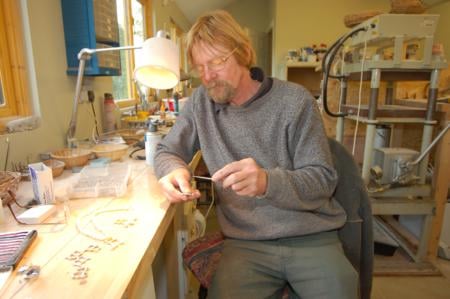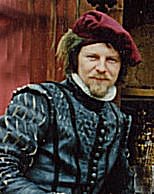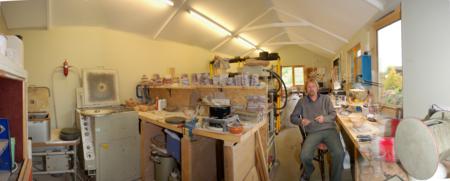I thought it would be interesting to do a series of posts on The Anne Boleyn Files team, the craftspeople behind our jewellery, costume and other products, and today we start with Steve Millingham who makes our gold-plated B necklace, A Necklace, state chains and portrait replicas. Over to Steve…

From Photographer to Jeweller
I studied photography at college – planned to become a war photographer – but then I met a friend in a pub in my old home town whilst on summer vacation and he (dressed as a cavalier) explained he was off to a battle. With my plans for war photography and reportage this sounded like fun, so I was soon also dressed as a Cavalier and taking part in battles.
The other soldiers carried pikes and muskets, but I went in to battle with my two Nikons!
 When college finished I didn’t know what to do with myself as I had given up on photography as a career (more photographers than civil servants in London I was told), so I became a postman for three years. During this time, my girlfriend, Sue, was studying for a BA in ceramics, so I started making little clay medals to commemorate the battles. They sold out every time so we started as the first re-enactment merchants, this was back in 1978. To begin with, we made everything out of clay, but a pewter company started to appear regularly on Merchants Row, so I knew I had to start making my medals in pewter. That is where it all started.
When college finished I didn’t know what to do with myself as I had given up on photography as a career (more photographers than civil servants in London I was told), so I became a postman for three years. During this time, my girlfriend, Sue, was studying for a BA in ceramics, so I started making little clay medals to commemorate the battles. They sold out every time so we started as the first re-enactment merchants, this was back in 1978. To begin with, we made everything out of clay, but a pewter company started to appear regularly on Merchants Row, so I knew I had to start making my medals in pewter. That is where it all started.
My first centrifuge or casting machine was a cut down spin-drier and for casting alloy I bought the metal sweepings off a printers floor. It was all trial and error and completely self-taught. As I improved, I started to use proper lead-free casting alloys and I expanded in technique from small medals to chains of office, which meant I was making bigger things by joining small things together. Not much of a technical advance, but then I started experimenting with making silicon rubber moulds and this led onto the bigger things like spoons and drinking vessels. All this time I was developing a small range of tudor jewellery, but in a pewter finish it didn’t look right. So then came gold-plating and the jewellery side of things took off.
Making the Jewellery
The technique starts with finding a jewel in a portrait or in a sketch and then seeing which size and type of stones are available commercially. With this as the starting point, I then re-draw the jewel to fit the stones. Then, I engrave the design into plaster of paris (for this you need to work inside out and back to front, which is something I can do naturally). Then a putty is pushed into the engraving which, when baked, goes rock hard. Now I have the jewel in relief and the right way round.
The next step is to pierce out the design using piercing saw blades almost as fine as a hair (you can’t see the teeth of the blades but you can feel the direction of the teeth by rubbing your finger along the blade). Then you have to finish the ‘master’ with very fine needle files. When all the stones are fitted (to check for size) and all the details are clear, then the ‘master’ is ready to go into the vulcanising press. For this process, the jewel is placed between two circular sheets of rubber, these rubber discs then are encased in a steel mould can and put into the press which heats the rubber to 150ºc and puts it under massive pressure. After a period of time the rubber is vulcanised and the discs are taken out and parted. This is where you cross your fingers as the process destroys the master! The mould then has vents and sprues cut to allow the entry of the molten metal.

For the best definition in the castings, the mould is spun at 700rpm in the hydraulically controlled centrifuge and the molten metal is poured in, being flung from the centre into the cavity left by the master. The castings are then removed from the sprues and the files are out again to removed any trace of sprues or vents. Next step is to barrel polish the castings, where they go into a barrel of polished steel shot which rotates until the polish on the shot is transfered to make the castings brightly polished also. Then the castings go off for electroplating and come back some weeks later for assembly and stone setting.
Then, the pearl necklaces have to be made up. I have to make sure that all the pearls match, even if this means shopping around for ages to match pendant pearls to necklace pearls.
Films, TV Series and Productions Steve Has Worked On
- The Tudors
- Downton Abbey
- The Golden Compass
- Stage Beauty
- Pirates of the Caribbean 1 and 4
- Elizabeth
- A Man for All Seasons (West End Stage show with Martin Shaw)
- Heartbeat
- Hot Fuzz
- Sharpe (Sean Beans buttons)
and many more!
You can see more details on Steve’s jewellery on the following pages:-

Hello. what a wonderful article. wouldn’t Steve be amazing, giving his talks to children and teenagers. He is inspirational. thank you.
Lovely!
I’ve bought quite a few really lovely pieces from Mr. Millingham and it’s great to get to see his workshop here and get to know him a bit. Great article and a great jeweller! 🙂
What a great idea – it’s nice to learn more about the people and the processes that go into all the beautiful pieces you have available. I’m looking forward to more!
I too have bought from Master Millingham too 🙂 He does some nice periodic things, which are very like true likenesses of the actual thing that he is recreating 🙂
It is nice to know where my “B” necklace, “A” necklace, and “B” brooch came from. Kind of like seeing their nursery.
What a great article! Does Steve have his own website? Dare I say – can we commission pieces?
Steve can commission pieces so you can email me at claire@theanneboleynfiles.com with details of what you want done and I can have a chat with him.
That is fantastic. I can’t get it right now, but in a couple of months I know for certain that I will be able to, and for a very long time I have had in my head a couple of custom pieces. I’m guessing, given the amazing range of work that Steve has done, I’m not limited to solely Tudor period pieces?
No, you’re not limited at all by era as he does all sorts. Obviously custom pieces are more expensive as he has to design them from scratch and then design and create a mould for casting, which is why we only offer the B and A pendants as he has made those two casts.
I purchased Steve’s “B” necklace and absolutely loved it. Amazing craftsmanship and a beautiful piece of jewelry. Always a topic for discussion! 🙂
I have three pottery items acquired from Steve 35 years ago. Splendid they are and they still take pride of place in our sitting room.